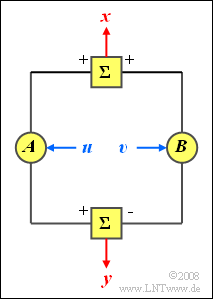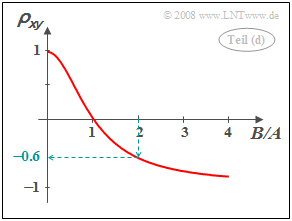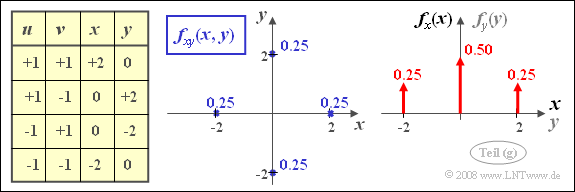Exercise 4.7: Weighted Sum and Difference
Let the random variables $u$ and $v$ be statistically independent of each other, each with mean $m$ and variance $\sigma^2$.
- Both variables have equal probability density function $\rm (PDF)$ and cumulative distribution function $\rm (CDF)$.
- Nothing is known about the course of these functions for the time being.
Now two new random variables $x$ and $y$ are formed according to the following equations:
- $$x = A \cdot u + B \cdot v,$$
- $$y= A \cdot u - B \cdot v.$$
Here, $A$ and $B$ denote (any) constant values.
- For the subtasks (1) to (4) let $m= 0$, $\sigma = 1$, $A = 1$ and $B = 2$.
- In subtask (6) $u$ and $v$ are each uniformly distributed with $m= 1$ and $\sigma = 0.5$. For the constants, $A = B = 1$.
- For subtask (7) it is still valid $A = B = 1$. Here the random variables $u$ and $v$ are symmetrically two-point distributed on $\pm$1:
- $${\rm Pr}(u=+1) = {\rm Pr}(u=-1) = {\rm Pr}(v=+1) = {\rm Pr}(v=-1) =0.5.$$
Note: The exercise belongs to the chapter Linear Combinations of Random Variables.
Questions
Solution
- $$m_x = (A +B) \cdot m \hspace{0.15cm}\underline{ =0}.$$
- For the variance and standard deviation:
- $$\sigma_x^2 = (A^2 +B^2) \cdot \sigma^2 = 5; \hspace{0.5cm} \sigma_x = \sqrt{5}\hspace{0.15cm}\underline{ \approx 2.236}.$$
(2) Since $u$ and $v$ have the same standard deviation, so does $\sigma_y =\sigma_x \hspace{0.15cm}\underline{ \approx 2.236}$.
- Because $m=0$ also $m_y = m_x \hspace{0.15cm}\underline{ =0}$.
- For mean-valued random variable $u$ and $v$ on the other hand, for $m_y = (A -B) \cdot m$ adds up to a different value than for $m_x = (A +B) \cdot m$.
(3) We assume here in the sample solution the more general case $m \ne 0$. Then, for the common moment holds:
- $$m_{xy} = {\rm E} \big[x \cdot y \big] = {\rm E} \big[(A \cdot u + B \cdot v) (A \cdot u - B \cdot v)\big] . $$
- According to the general calculation rules for expected values, it follows:
- $$m_{xy} = A^2 \cdot {\rm E} \big[u^2 \big] - B^2 \cdot {\rm E} \big[v^2 \big] = (A^2 - B^2)(m^2 + \sigma^2).$$
- This gives the covariance to
- $$\mu_{xy} = m_{xy} - m_{x} \cdot m_{y}= (A^2 - B^2)(m^2 + \sigma^2) - (A + B)(A-B) \cdot m^2 = (A^2 - B^2) \cdot \sigma^2.$$
- With $\sigma = 1$, $A = 1$ and $B = 2$ we get $\mu_{xy} \hspace{0.15cm}\underline{ =-3}$. Tthis is independent of the mean $m$ of the variables $u$ and $v$.
(4) The correlation coefficient is obtained as
- $$\rho_{xy} =\frac{\mu_{xy}}{\sigma_x \cdot \sigma_y} = \frac{(A^2 - B^2) \cdot \sigma^2}{(A^2 +B^2) \cdot \sigma^2} \hspace{0.5 cm}\Rightarrow \hspace{0.5 cm}\rho_{xy} =\frac{1 - (B/A)^2} {1 +(B/A)^2}.$$
- With $B/A = 2$ it follows $\rho_{xy} \hspace{0.15cm}\underline{ =-0.6}$.
(5) Correct are statements 1, 3, and 4:
- From $B= 0$ follows $\rho_{xy} = 1$ ("strict correlation"). It can be further seen that in this case $x = u$ and $y = u$ are identical random variables.
- The second statement is not true: For $A = 1$ and $B= -2$ also results $\rho_{xy} = -0.6$.
- So the sign of the quotient does not matter because in the equation calculated in subtask (4)' the quotient $B/A$ occurs only quadratically.
- If $B \gg A$, both $x$ and $y$ are determined almost exclusively by the random variable $v$ and it is $ y \approx -x$. This corresponds to the correlation coefficient $\rho_{xy} \approx -1$.
- In contrast, $B/A = 1$ always yields the correlation coefficient $\rho_{xy} = 0$ and thus the uncorrelatedness between $x$ and $y$.
(6) Both statements are true:
- When $A=B$ ⇒ $x$ and $y$ are always uncorrelated $($for any PDF of the variables $u$ and $v)$.
- The new random variables $x$ and $y$ are therefore also distributed randomly.
- For Gaussian randomness, however, statistical independence follows from uncorrelatedness, and vice versa.
(7) Here, only statement 1 is true:
- The correlation coefficient results with $A=B= 1$ to $\rho_{xy} = 0$. That is: $x$ and $y$ are uncorrelated.
- But it can be seen from the sketched two-dimensional PDF that the condition of statistical independence no longer applies in the present case:
- $$f_{xy}(x, y) \ne f_{x}(x) \cdot f_{y}(y).$$


